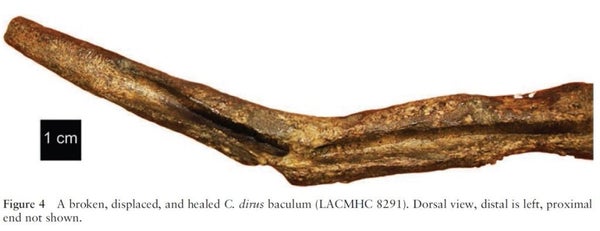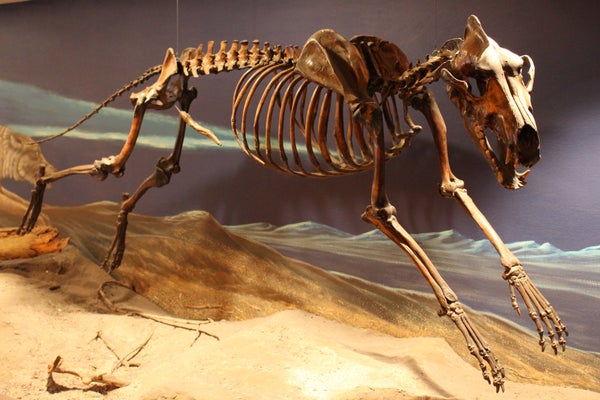This article was published in Scientific American’s former blog network and reflects the views of the author, not necessarily those of Scientific American
We’ve all had moments of sympathy pain. That little twinge when we see or hear about a fracture, burn, kick in the groin, or other familiar trauma that hits a little too close to home. This phenomenon crosses species boundaries. I know because I just read a paleontology paper with an injury that made me clench my jaw and suck the air through my teeth.
The study, written by Adam Hartstone-Rose and colleagues, is titled “The Bacula of Rancho La Brea.” It’s all about Ice Age penis bones. While we lack the genital bones of our ancestors – the baculum in males and baubellum in females — they’re pretty common in other groups of mammals, and paleontologists working at Los Angeles’ famous asphalt seep have pulled hundreds of os penis from the ancient mire.
The sample includes specimens from coyotes, weasels, badger, and fox, but dire wolves far outstrip the competition with about 400 hundred bacula, 159 of which are complete. But not all of these bones are in good health. Eight of the dire wolf bacula in the La Brea sample bear some kind of pathology. “Most of these demonstrate some degree of twisting along the long axis that may have been either congenital or the result of trauma”, Hartstone-Rose and coauthors write. And of this smaller sample, a few bacula are fractured.
On supporting science journalism
If you're enjoying this article, consider supporting our award-winning journalism by subscribing. By purchasing a subscription you are helping to ensure the future of impactful stories about the discoveries and ideas shaping our world today.

The broken baculum of a La Brea dire wolf. Credit: Hartstone-Rose et al. 2015
LACMHC 8291 had an especially rough time of it. The caption accompanying the image reads “A broken, displaced, and healed C. dirus baculum”, meaning that the tip broke and healed in a different position than it started. That was enough to make me cross my legs while reading the paper.
Without what would be one of the stranger sets of time travel coordinates ever, we’ll never know exactly what happened to the poor wolf. The leading hypothesis for the injury is that the unfortunate male was accosted by a rival in the middle of The Act, which would “cause the mating male to jump suddenly and snap the bone.”
As cringe-inducing as such injuries may be, though, they are relatively rare among La Brea’s dire wolves. The number of broken bacula is actually lower than expected for the sample size compared to the incidence the same breaks in their modern relatives. The size of dire wolf bacula, Hartstone-Rose and colleagues suggest, might explain why.
The os penis of adult dire wolves were about 44% longer than those of gray wolves, not to mention significantly more massive. This made it a tougher bone to break. Paired with the unexpected rarity of baculum injuries, the paleontologists propose, this might mean that the modified members of dire wolves were an evolutionary response to competition for mates. So in evolutionary terms, the solution for dire wolves was to walk softly and carry a big stick.
Reference:
Hartstone-Rose, A., Dundas, R., Boyde, B., Long, R., Farrell, A., Shaw, C. 2015. The bacula of Rancho La Brea. Natural History Museum of Los Angeles County Science Series, 42. pp 53-64
[This post was originally published at National Geographic.]
